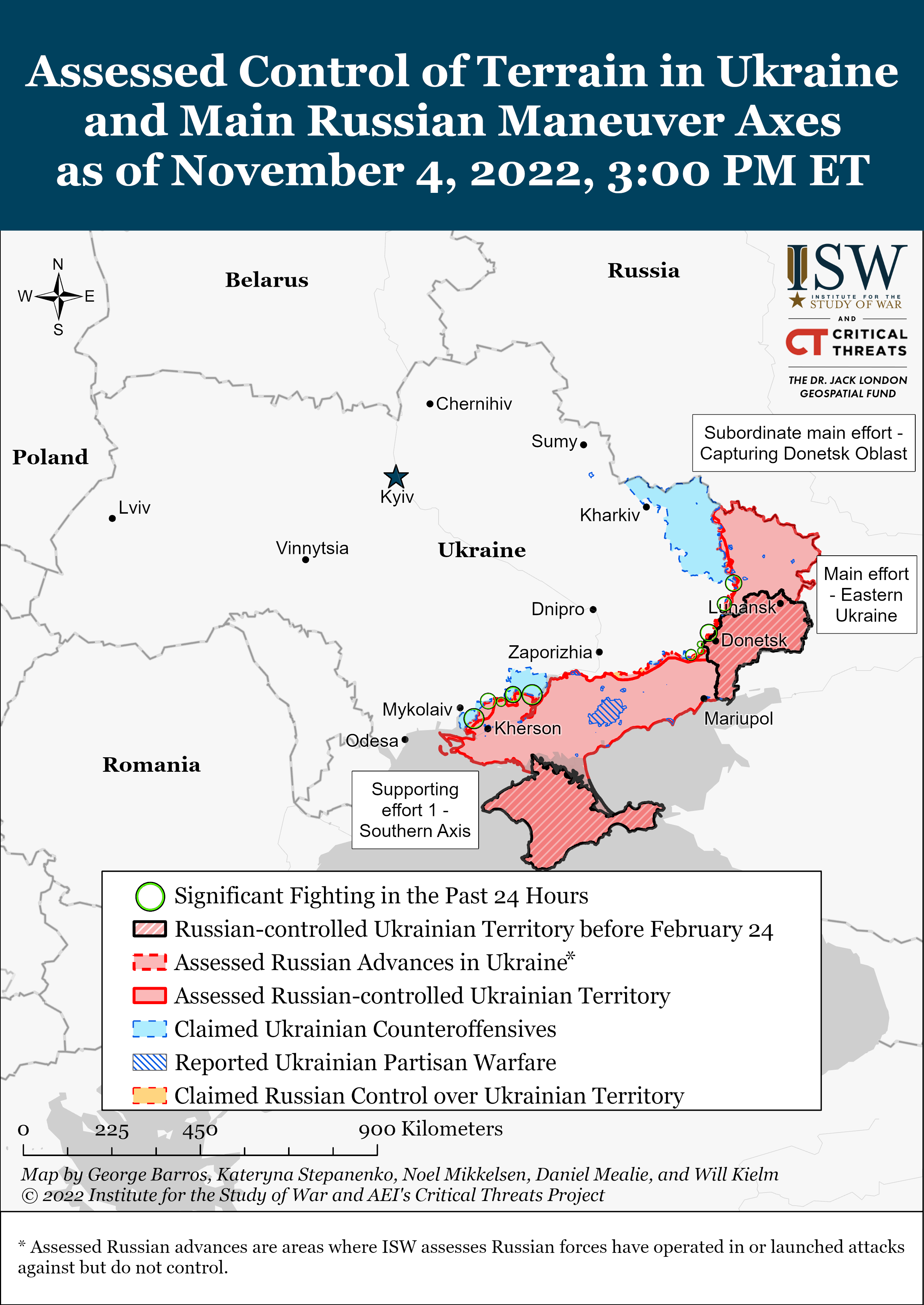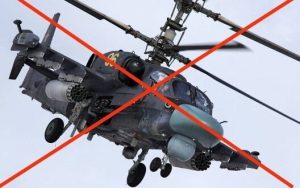
ISW Russian Offensive Campaign Assessment, November 4 – Kyiv Post
Key Takeaways
- The Russian military is likely trying to use mobilized personnel to restart its Donetsk offensive but will likely fail to achieve operationally significant gains.
- Russian forces are setting conditions for an orderly withdrawal from the west bank of the Dnipro River to avoid a rout in Kherson Oblast.
- President Vladimir Putin is likely setting conditions to continue mobilization covertly despite claims that partial mobilization produced sufficient forces.
- Russia’s costly force generation measures will likely continue to weigh on the Russian economy and generate social tensions.
- Iran is likely exploiting Russian reliance on Iranian-made weapon systems to request Russian assistance with its nuclear program.
- Russian forces may be deploying extreme measures against deserting personnel in an attempt to respond to severe morale issues.
- Russian sources claimed that Ukrainian forces continued counteroffensive operations in the direction of Kreminna and Svatove.
- Russian forces continued to prepare existing and new defensive lines in Kherson Oblast.
- Russian forces continued to conduct offensive operations around Bakhmut, Avdiivka, and Donetsk City.
- Russian forces continued forced evacuation measures in Kherson Oblast.
- Russian and occupation officials continued to set measures for the forced deportation of Ukrainian children to the Russian Federation.
The Russian military is likely trying to use mobilized personnel to restart the Donetsk offensive but will likely still fail to achieve operationally significant gains. Commander-in-Chief of the Ukrainian Armed Forces General Valerii Zaluzhnyi reported on November 4 that Russian forces have tripled the intensity of hostilities in certain sections of the front with up to 80 daily assaults.[1] The Ukrainian General Staff reported that Russian forces are currently focusing those offensive operations in the direction of Bakhmut, Avdiivka, and western Donetsk Oblast.[2] The Ukrainian Eastern Group of troops spokesperson Serhiy Cherevatyi stated on November 4 that Russian forces are likely trying to seize Bakhmut and Soledar in Donetsk Oblast so that Russia can declare some type of success by announcing the “liberation” of the Donbas (even though those gains would not give Russia control over the entire region).[3] Cherevatyi also noted the presence of mobilized men in the Bakhmut direction, an area that should not in principle see many mobilized personnel given the extensive presence in this area of Wagner Group and proxy units that should not be receiving large numbers of Russian reservists.[4] ISW previously assessed that Russian forces prematurely impaled an insufficient concentration of mobilized personnel on offensive pushes near Bakhmut and Vuhledar in Donetsk Oblast on November 3.[5] The apparent intensification of Russian assaults in Donetsk Oblast likely indicates that Russian forces are repeating that mistake throughout this section of the front. The increased quantity of personnel at frontline positions may allow Russian forces to achieve some gains in Donetsk Oblast, but poor training, logistics, and command will continue to prevent Russian forces from making operationally significant gains that would materially affect the course or outcome of the war.
Russian forces are setting conditions for a controlled withdrawal in northwestern Kherson Oblast, likely to avoid a disorderly rout from the right (west) bank of the Dnipro River. Russian forces will likely need to engage in a fighting withdrawal to prevent Ukrainian forces from chasing them onto the left (eastern) bank. Ukraine’s Southern Operational Command corrected social media reports from November 3 regarding the destruction of civilian boats and piers along the Dnipro River.[6] Ukraine’s Southern Operational Command stated that Russian forces are purposefully destroying civilian vessels and are restricting civilian use of watercraft and access to the shore. The corrected story likely corresponds with the reports of Russian forces preparing defensive positions on the left bank and the withdrawal of certain elements and suggests that Russian forces are eliminating ways for Ukrainian forces to chase them across the river during or after a withdrawal. Local Ukrainian sources also shared geolocated footage that reportedly showed the aftermath of the recent Russian destruction of a pedestrian bridge over the Inhulets River in Snihurivka (about 60km east of Mykolaiv City), which may also indicate Russian efforts to slow Ukrainian advances amidst a Russian withdrawal.[7]
Russian President Vladimir Putin is likely setting conditions to continue covert mobilization, which suggests that partial mobilization did not generate sufficient forces for Putin’s maximalist goals in Ukraine despite Putin’s claims to the contrary. Putin announced on November 4 that Russian forces mobilized 318,000 men of the 300,000 authorized due to the recruitment of volunteers during the mobilization period.[8] Putin added that Russia had already committed 49,000 men to combat missions. Putin’s claims of a successful and completed mobilization are inconsistent with his November 4 decree that allows Russian officials to mobilize citizens with outstanding convictions for some serious crimes.[9] Putin also signed decrees extending the status of servicemen to men serving in volunteer formations and outlining mobilization exemptions for citizens undergoing alternative service.[10] Such decrees likely indicate that Putin is preparing to continue covert mobilization in Russia by attempting to incentivize volunteer service or setting conditions to mobilize convicts—given that he has yet to sign an order terminating mobilization as of November 4.[11] Provisions authorizing the mobilization of prisoners may also indicate that Putin is trying to preempt social tensions by setting conditions to mobilize convicts instead of civilian Russian men.
Russian opposition and online outlets have reported that Russian authorities and businesses are preparing for a second mobilization wave by modernizing military recruitment centers and preparing lists of eligible men.[12] Rostov, Kursk, and Voronezh Oblast governors have also previously spoken about conducting a second wave of mobilization, and a few men reported receiving summonses for 2023.[13] While it is unclear if the Kremlin will double down on covert mobilization or initiate another mobilization wave, Putin’s decrees are indicative of the persistent force generation challenges that have plagued the Russian military campaign.
Russia’s costly force generation efforts will continue to weigh on the Russian economy and could ignite social tensions if the Kremlin does not fulfill its financial obligations to the participants of the “special military operation.” Putin signed a decree granting a one-time payment of 195,000 rubles (about $3,150) to mobilized men and individuals who had signed a contract after the declaration of partial mobilization on September 21.[14] By committing to pay mobilized men and giving the status of servicemen to volunteers the Kremlin is adding another financial burden to Russia’s economy.[15] Russian governors are already releasing statements attempting to justify delays in compensating mobilized men and their families citing budget issues and the need to finance supplies for Russian servicemen.[16] Failures to make payouts to mobilized men are already causing social tensions in Chuvash Republic, for example, where 1,800 men are demanding that the region immediately pay the promised 400 million rubles (about $6.5 million) to the mobilized population.[17]
Iran is likely already exploiting Russian reliance on Iranian-made weapons systems to request Russian assistance with its nuclear program. CNN reported on November 4 that unspecified US intelligence officials believe that Iranian officials have been asking Russia for help in acquiring additional nuclear materials and with nuclear fuel fabrication.[18] Nuclear fuel could allow Iran to shorten the breakout period to create a nuclear weapon depending on the kind of fuel and the kind of reactor for which it is being requested. CNN reported that it was unclear whether Russian officials had agreed to Iranian requests.[19] ISW has previously reported that Iranian plans to send more combat drones and possibly ballistic missile systems to Russia will likely strengthen Russia’s growing reliance on Iranian-made weapons systems.[20]
Ukrainian Main Military Intelligence Directorate (GUR) representative Andriy Yusov stated on November 4 that GUR has not received information confirming that Iranian missile systems have arrived in Russia despite intelligence that confirms the contract for the transfer of those systems.[21] Yusov also stated that another shipment of 200 Iranian-made combat drones to Russia is currently underway.[22] Ukrainian Minister of Defense Oleksii Reznikov reported on November 4 that Russian forces have almost completely used up the first set of 300 combat drones from Iran.[23] Reznikov reported that Russia currently has contracts to receive 1,500 to 2,400 more Iranian-made combat drones, assuming Iran can fill the orders.[24] Russia’s growing reliance on these systems allows Iran to exert greater influence on Russian officials, and Iranian officials have already likely started to exploit that influence in support of its nuclear program. The Iranian requests for Russian assistance with its nuclear program may be an indicator of an intensifying Russian Iranian security partnership in which Iran and Russia are more equal partners.
Russian forces may be deploying extreme measures against deserting personnel in an attempt to respond to severe morale issues. The United Kingdom Ministry of Defense (MoD) reported on November 4 that Russian forces in Ukraine probably have started deploying “barrier troops” and “blocking units”, units that threaten to shoot their own retreating personnel to compel offensives.[25] The UK MoD reported that Russian generals likely want their subordinate commanders to shoot deserters, including possibly authorizing personnel to shoot to kill their own deserting servicemen.[26] Desertion in the face of the enemy is a capital offense in many militaries, including America’s.[27] The deployment of designated units or individuals behind friendly lines to shoot deserters is nevertheless indicative of just how low the morale, discipline, and cohesion of Russian military forces in parts of Ukraine have become.
See the full report here.


Average Rating